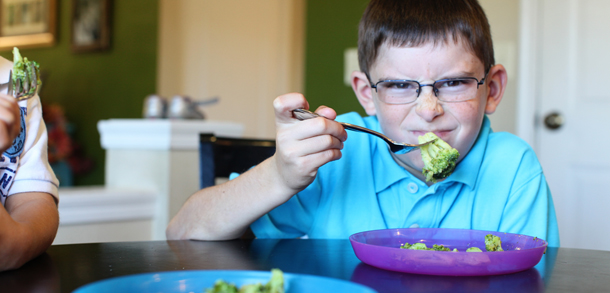As a pediatric dietitian I thought feeding my children would be easy.
This was the case for my first child, but it was not for my second. My youngest did not like eating and refused things I thought were good for him. He was also underweight. His eating habits were running our family and took all the fun out of meal time.
I realized that just because I am trained in child nutrition and know what the healthiest foods are for kids to eat, it does not mean that my child will eat those foods just because I put them in front of him. Feeding our children is much more than what we offer, but also about how you offer it while taking your child’s personality traits into consideration.
After months of making sure there were decreased distractions at mealtimes, offering foods in fun shapes, and making nutritious, high calorie foods to help with weight gain, I still had a very picky eater, which brought this mother to tears on multiple occasions. I hated mealtimes at my house.
So I decided to consult my colleagues on the feeding team at Cincinnati Children’s.
I found their advice helpful. Through their evaluation, they discovered that he had some mild sensory issues that could have been causing some of his unwillingness to try new foods. They provided me with ideas I could use at home to encourage him to try new foods and make mealtimes less of a struggle.
Since many families grapple with the same issue, I thought it might be helpful to compile a list of tips from my experience working with feeding team as well as things I have learned along the way as a mother and dietitian.
Here are five tips to help improve the variety in your child’s diet:
- Give your child independence at meals. Prior to getting help for my son I would pre-plate his food. When we went to feeding team they asked him to serve his own food. He did and he ate it. We now serve as many meals as we can family style at our house and allow the kids to serve themselves. My boys were 3 and 5 when we started this on a regular basis. Sometimes there is some mess involved, but they are proud to accomplish the task.
- Consider a multivitamin. If you are worried that your child is not getting the right nutrients, a multivitamin can help fill the nutritional gap while you work on expanding variety. If your little one does not like to eat meat then use a children’s multivitamin that has iron in it. Gummie vitamins are very popular, but they typically do not have iron. Consult the package instructions for the correct dosage.
- Observe what makes your child try new foods. A sibling can help with this. My younger son would love to sit and share what was left of the snack I had packed his older brother for preschool. I started to pack things that I wanted my younger son to try and he would eat it and enjoy it. This was how his fruit and vegetable intake got better. Other children may like to pick out food in the grocery store and come home to help make it. Some may like playing with food (let them feel it and explore it) prior to trying it as a way to get used to it.
- Have realistic thoughts of what your child should eat. Did you know that a serving of meat for a preschooler is 1 ounce (equal to about 1/3 of a deck of cards)? Did you know that they only need 4 ounces per day of protein/meat? Many parents are concerned when their child does not eat the protein or entrée at dinner. It could be because one of their favorite foods is turkey and they had a good-sized turkey sandwich at lunch. Therefore, if they want to only have fruit and milk for dinner it is probably ok. Look at what your child eats the whole day and not just for one meal. For more information on appropriate serving sizes for kids refer to choosemyplate.gov.
- If your child is picky and underweight try to not offer food continuously. Offer foods at regular meal and snack times. Include nutrient dense foods that will give them more calories such as, cheese, nut butters, whole milk yogurt, and bananas. Some parents use fortified pediatric beverages to supplement their child’s intake if they are underweight. Some of those available include Pediasure, Boost Kids Essentials, and Pediasmart (an organic choice). If your goal is for your child to eat more food then you should limit the use of these beverages to snack time and make sure they are not filling up on the beverage rather than eating food.
My son is now doing much better. He is not “cured” because I have discovered that his eating is part of his personality and now I know how to manage his likes and dislikes in a way that encourages a positive family meal experience.
If you are struggling with your child’s eating habits and are concerned that his/her diet is less than optimal, discuss this with your pediatrician. Your doctor may consider a referral to a registered dietitian.







I have a daughter and she is4 and I have a eating disorder with her she is slim and she a picky.